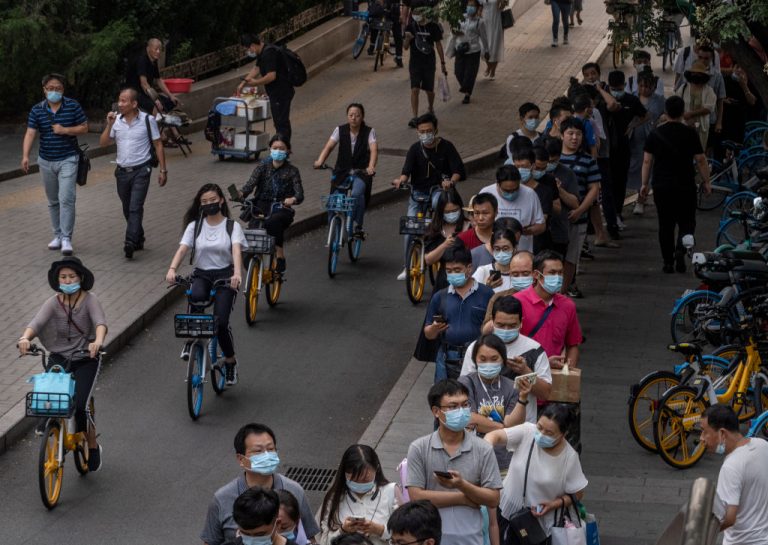China is battling its worst COVID-19 outbreak in months — fueled by the Delta variant — which has forced authorities in several regions to lock down cities, suspend key transportation routes, cancel flights and order mass nucleic acid testing for large swaths of the population.
On Monday, Aug. 9, the Chinese authorities confirmed another 125 cases of the novel coronavirus nationwide including in the city of Yangzhou in Jiangsu Province. At least 58 people had been diagnosed with COVID-19 on Aug. 5, the highest number admitted to by the authorities in a single day in the current outbreak. By Friday, Aug. 6, more than 4.5 million residents were ordered to stay home; highways and rail were shut down to curb the virus.
In flood-hit Zhengzhou city, reports have surfaced indicating another 35 locally transmitted COVID-19 cases. All of the 35 cases are believed to be asymptomatic, according to the headquarters of COVID-19 prevention and control.
“Since July 30, Zhengzhou has reported a total of 116 locally transmitted confirmed cases and 12 asymptomatic cases in the latest COVID-19 outbreak, according to the headquarters,” the state-run Xinhua reported.
On Wednesday, Aug. 4, China reported the most new locally transmitted COVID-19 cases since January with 71 new locally acquired cases. The Chinese National Health Commission (NHC) declared that more than half of these cases were connected to an outbreak in the coastal province of Jiangsu. The Jiangsu city of Zhangjiajie is now being considered the epicenter of the current outbreak.
Success
You are now signed up for our newsletter
Success
Check your email to complete sign up
Previously, on July 31, the city of Nanjing, the capital of Jiangsu, reported 55 new coronavirus cases, 30 of which were local cases, the NHC said in a statement. Local authorities traced the infections back to airport workers who cleaned a plane which arrived from Russia.
The outbreak in Jiangsu represents only a fraction of the emerging outbreaks across China. Cases have been reported in 17 of China’s 31 provinces.
Wuhan under lock down, again
In the city of Wuhan, where the virus first took hold, then spread across the globe, local authorities have again ordered mass nucleic acid testing of the entire population while suspending flights, trains and cancelling professional basketball league games.
Wuhan, a provincial capital and home to approximately 11-million people, is only the latest city to under-go city-wide testing.
The speed and scale of the spread has forced authorities to enact domestic travel restrictions with authorities banning inter-city coach, taxi and online car hailing services in areas deemed medium to high risk.
On Aug. 2, seven infections were discovered among migrant workers in the city and on Wednesday August 3, 20 new local infections were reported including eight asymptomatic cases, according to the Hubei provincial health commission (HPHC).
“The cumulative number of cured cases discharged from hospital is 63,665, the cumulative number of deaths is 4,512, the province reported a total of 68,210 confirmed cases of new crown pneumonia.” HPHC said in an online statement.
Widespread restrictions enacted in Beijing
In Beijing, China’s bustling capital, authorities restricted entry into the city for people coming from high-risk areas in an attempt to protect the capital from a further surge in COVID-19 infections.
Flights and long-distance trains from affected areas were cancelled with authorities urging residents to stay home and avoid all travel to any affected regions.
Residents of Beijing need to supply proof of a negative nucleic acid test, within 48-hours of departure, in order to leave the city.
Six residential complexes in Beijing have been locked down including in Haidian and two others in Fangshan following the discovery of three residents, all of the same family, who tested positive for the virus.
“At present, the global epidemic is rapidly intensifying and the risk of imported infections is increasing,” said Mi Feng, spokesman at the National Health Commission on Wednesday, adding that, “recently, imported-related cases have been detected at many airports, ports and hospitals, resulting in a spread (of infections) of a certain scale,” Reuters reported.
China now has over 140 areas deemed to be high or medium-risk, the most since the peak of the epidemic in the spring of 2020, Reuters reported.
Surging infections despite mass inoculation
According to the New York Times’ COVID-19 Vaccination Tracker, mainland China has administered in excess of 1.78 billion vaccine doses, however this level of inoculation does not appear to be slowing the spread of the disease.
China’s hardline “zero-Covid” strategy appears to be buckling under the stress of the Delta strain as breakthrough infections surge among the vaccinated public.

The Delta variant, which appears to cause more severe illness and spreads as easily as chickenpox, is wreaking havoc across the globe and is being blamed for numerous “break-through” infections in China.
China developed two coronavirus vaccines, Sinovac and Sinopharm that were both approved by WHO for global use and have been heavily relied upon to vaccinate the Chinese public.
The Sinovac vaccine has been deemed 51 percent effective and the Sinopharm vaccine 78.1 percent effective.
The vaccines, which appear to be useful in decreasing the severity of symptoms, also appear to be doing little to prevent the spread of the virus.
Over 90 countries are currently using the Chinese vaccines, according to Axios, including Bahrain, Chile, Mongolia and Seychelles; however, all of these countries are experiencing a recent surge in infections.
The potential ineffectiveness of Chinese vaccines has far-reaching implications. Public trust in vaccines is at risk and convincing people to get vaccinated — or to get another vaccine booster shot — may prove increasingly difficult, The New York Times reported.














